Kandar – The Land of Fighters
April 3, 2006
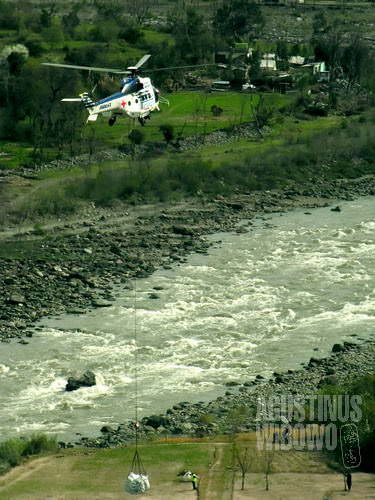
Helicopter bringing aids to Harama. Imagine how those angry fighters hijacked the flying copter
First, the rumors. The name of Kandar is full of myth, ask every villager of Noraseri, and his face will be filled by fear. Not only villagers from Noraseri, but the fame of Kandar had reached areas as far as Pattika and Muzaffarabad. The people of Kandar had made their popularity around the hills.
Kandar, located on the top of the hill just behind, is visible from Noraseri. Seemed as close it was, the real four kilometer distance was somehow an unreachable gap for the villagers from Noraseri. It was the image of Kandar which put down the people of other villages. I have heard the rumor about Kandar for the first time from Rashid who told me how ‘nonsense’ these people were. Rashid said that no NGO was working there, as the NGOs were afraid of Kandari. Kandar, accidentally the name resembled “Kandahar”, one of the most dangerous areas in Afghanistan. It was a joke that Kandar was Kandahar of Kashmir. Once upon a time in history, somewhere in a time dimension after the disaster, there happened a helicopter was hijacked by the people of the village. How could the villagers, mostly uneducated, and was not on board, could hijack the flying helicopter? The story itself sounded quite mystical. Rashid said that the people climbed from the rope which brought the relief materials, then put down the pilot. What happened to the pilot? The story turned to be a horror. I was fully questioned at that time, so mysterious, so unbelievable. And it was the first time the idea of finding out the real face of Kandaris came to my mind.
Rashid added, those people refused the existence of any relief teams. They didn’t want outsiders to ‘help’ them to distribute the relief goods. They wanted to distribute themselves. The helicopters even didn’t want to land anywhere near the area. Instead the Kandaris had to go to a helipad in Harama, about five kilometers mountainous path journey, to get the relief goods. And even that the landing point of the relief goods had been shifted to another village, the Kandaris still fought each other to ‘distribute the goods by themselves’.

They say, all Kandar men are powerful
How these people look? Weren’t they just like ‘normal’ people, considering that their habitat was just somewhere four kilometers away? Rashid said that Kandaris had special feature, they always brought sticks when wandering around. The stick, of course, was used to beat in fighting. They also tend to wear shawl. The stick and shawl, somehow make you remember to the Pasthun warriors in Afghan borders, was the characteristics of the pride of Kandaris. And even without these things, local people still can recognized the Kandaris, as they were special, from the way of walking or speaking.
Rashid information was confirmed by local people of Noraseri. When I expressed my willingness to go to Kandar, I heard another story. Uncle Bashir of Noraseri, once was invited to a wedding in Kandari. The wedding was so ridiculous, that everybody who heard this story might question its accountability. As guests, they were coming very painfully, walking the difficult path of five kilometers, high up the hills. But the hosts, some old men, angrily and told them unfriendly, loudly, that the hosts wanted to eat first. Guests should wait outside. After sometime, the hosts finished eating, they forced the guests to go in, to have the rest of the food. That unfriendly, that even for eating the rest food, the guests had to serve themselves. Some Kandaris even fought during the wedding party, to get more rice or meat. Fighting and wedding, somehow, might walk hand in hand for Kandaris.
Going to Kandar, this idea might suddenly change the face of your fellow Noraseri friends. “Don’t go there, you will die!” said Samera. “Kandaris are harami people,” said doctor Zaman. Everybody suggested me not to go. Except one. Farmanshah, the healthy 36 man, politician of PPP party, in the contrary, suggested me to go there. And it was not only because he had some friends there in Kandar so I chose him as my ‘travel guide’, he was also strong physically and politically. His healthy body, some people joked that he had three unborn sons, was a huge guarantee. But his political power as a respected person in that area made me sure that nothing wrong would happen (hopefully). And he was so kind to offer me the chance to go.
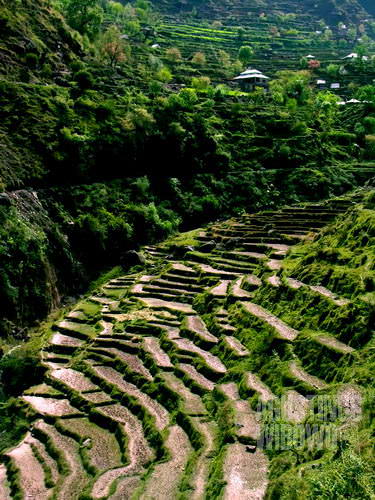
Here live the notorious fighter people
It was just two days after I heard the story of Kandaris that I departed there. It was 7:45 when I reached Farman’s house. 15 minutes late from original appointment. I thought it was normal. But Farman already had breakfast by himself, despite that he had invited me to have breakfast together. Doctor Zaman warned me a night before that Farman might take me to other place instead going to Kandar, as the way to go there might be painful for Farman’s healthy body. I regarded this as considerable information.
Just a dozen meter from Farman house was his owned school. He ran a private school, and his wife was a teacher. There had been five teachers, one had died in the disaster. There had been 67 students, but now only 55 left. Some had gone to other place as refugees, some died. There had been a school building, now it was replaced by a tent. One of the teachers was as young as fifteen years old. Later on I found that it was common in this area. Now the school had been turned to be a single classroom, or might be better, class tent. The three teachers of that day were teaching the students simultaneously. The students, young boys and girls of which some I had seen previously in the majlis on Farman’s rooftop, were sitting in rows. Writing and reading. No tables. Some girls were even sat on the floor to do some mathematic works. After the earthquake, the education had been reduced to the most essential points.
As private school, the tuition fee of the students was higher than the state schools. Farman said that it was merely a tuition fee, just enough to pay the salary of the teachers. The fee ranged from 100 to 160 rupees (less than 3 dollars) per month. It was not expensive. Farman said that people in this area were poor, so that education was not to extort money. But honestly, I felt that people in Noraseri were mostly quite rich before the disaster, as many of the houses were big and they owned satellite dish, some family even owned cars. After the disaster, the life was also reduced to very standard basic.
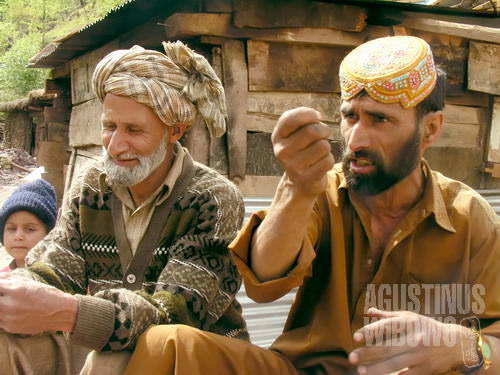
They are always enthusiastic when talking
Back to the journey to Kandar, it was a long way, but easy, from Noraseri to the back of the hill. Except for some points were the landslide came. To pass these paths, one should climb the big rocks coming from somewhere higher and blocked the narrow path. I, non mountain habitant, had to climb with my both hands. During the way I knew more about Farman’s background, about his political thinking and ambition, and his family.
He tried to give me a dramatic impression of Kandaris. Every time we met someone with beard and turban, Farman said, “He is Kandari,” or “He is from Kandar”. The poor target then would cry, “No!” I also didn’t think that Kandaris were identical with strange and rude look. Some Kandaris we met, some the real ones I mean, was looking exactly the same as the villagers from Noraseri. Kandar was only four kilometers away anyway.

Showing his destroyed house
Climbed up the hill, it was a steep climbing, before we arrived to the area that Farman claimed as the first house of Kandar. As a non local, I could not confirm whether it was true or not. Traveling with a guide limited me from the full contact with the people. I remembered doctor Zaman’s warning about Farman’s tactics. The four men we met were busy of building new shelters. Somehow I felt transported to Afghanistan or Peshawar, as three of the men were wearing turban, in a way that I had never seen before in Noraseri. The other man was wearing a Sindhi cap. The two men in turban were old, but quite strong. I saw when they grabbed my camera.
Were they as frightening as what Noraseri people told me? I couldn’t confirm. I was traveling with Farman. The material of the house that they were building was from Farman’s NGO, Farman said. And the machine of wood processing was his. Farman had an NGO? I didn’t know before. Farman himself was also receiving shelter home materials from our NGO. These four workers looked harsh, their way of speaking was more likely as screaming and quarreling. One of the old men had lost one of his right hand fingers. He said it was due to fighting (he used an onomatopoeia, dezim-dezim). I suspected it was due to the dangerous wood cutter machine.

Turban
Further on, the old man’s wife provided us lunch. It was oily egg tomato. Farman didn’t like egg, but he took half of my portion anyway. The roti was thin and crispy, which I liked very much. I had diarrhea today that I couldn’t eat a lot.
We stayed in this area for about an hour. I had urged Farman to continue the way, but he told me to rest for a minute. That a minute was for lunch. And it turned out to be twenty minutes. After the lunch we continued up, and we met Hanif, a young guy of 25 in blue shalwar khameez. He was the old man’s son. He wore very thick beard. But the sight of his eyes were curious and naughty, sometimes he tried to tease me by asking me to give him my camera, as a gift.

Their turban is distinctive
Hanif’s house was somewhere up. Nearby was the rubble of his house. The old man, the big Kandari as Farman said, showed me the rubble of the house which was swept by the stones of the landslides. “We don’t have any space!” cried Shar Zaman, the old, white bearded man. He showed me his ID and urged me to note down his name. Farman was rushing, and he did not hesitate to say that the old man was harami. I felt that both of them were good friends that the cursing didn’t evocate any anger or fighting.
Hanif then joined us, and his existence was indeed helpful for me to pass those landslide areas, the difficult dangerous paths. Balu, of which exact English translation I should find out, was his nickname, due to his innocent face. We arrived to a tent where two men were resting. They were building shelter home near the flattened house. The men were young. I asked about the fighting, as I didn’t see any fighting here. They said that they won’t fight in front of guests. But when the guests were not there, the dezim dezim would start. They told me about an English female social worker who was crying, frustrated about her job. I asked whether the locals were fighting when she came to distribute the food. They said no. They fought after she left.
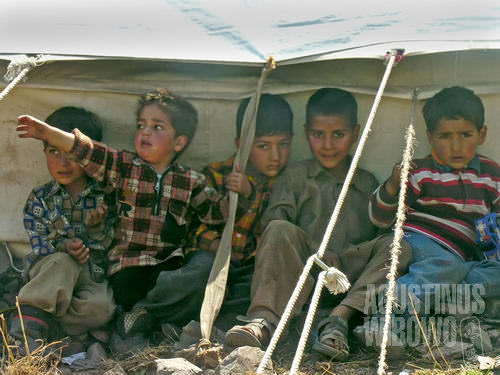
Don’t get mess with the fighting-loving Kandari people, including the little children
Upper, where Farman claimed as ‘Middle Kandar’, the middle part between the Lower and Upper Kandar, we met an old man who was proudly showing the pride of Kandaris, the shawl, the stick, and the gun. The shawl, sometimes used as turban, sometimes just put on the right shoulder, as people in Afghanistan, was mostly of simple bi-colored square design. The stick was walking stick. The gun I couldn’t comment, not from my knowledge.
Seeing a foreigner, children rushed. Some even was a little bit too hurry, that he didn’t notice he was wearing his sister’s or his mother’s woman shoes. These ‘little little Kandaris’ as Farman described, also did the ‘dezim dezim’.

Turban, stick, and boy—the prides of a Kandar man
Why Kandaris were so found of fighting? Farman explanation was, mostly people were uneducated. There were of course educated Kandaris. But they were only 10% of the population. The rest 90% were farmers, workers, labors. These people liked meat very much, and they didn’t hesitate to fight each other merely just for food. Those ones in wedding parties were mostly for this reason. A Kandari told me that it was funny that there was a marriage and the host made movie from the handycam of the wedding. And the movie also included the ‘expected but unexpected’ fighting. I was very interested to join such a wedding. Despite the fact that in Noraseri it was wedding season that almost everyday there was marriage, in Kandar it was completely no. The people was too poor, no money, no helicopter, no relief (these was their reason, other people said that relief teams did actually come to their village). No money, then no wedding. Simple reason.
About the hijacking, I met one of the hijackers. His name was Nawab Khan. Old but looked strong and brave. He said that there was no helicopter coming, despite of the existence of helipad in the village. People were angry. The Pakistan army didn’t allow helicopters of NGO to land. So once a helicopter of an NGO came and the people, 35 people he claimed, climbed and forced the pilot to get off. The pilot was brought to a discussion, the villagers told him to send relief. After the accident, there was not even any single helicopters nearby. The people had to go down to Harama to pick up their relief. And it was as Rashid said, Kandari people came with sticks and it was essential for food distribution, in their hilarious way.
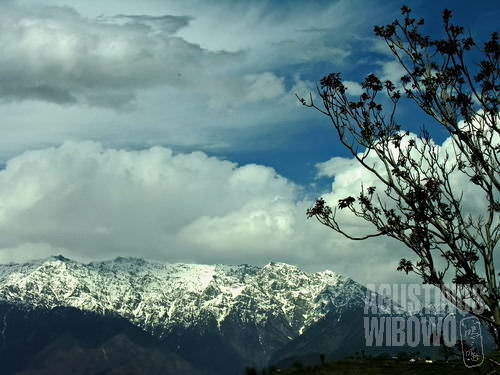
Kandar is located at top of the mountain
It was Behsar, 24, who told me that the rumor I had heard was completely wrong. He said that Kandaris were poor people, but they were nice people. Kandaris didn’t fight; it was only 25 people who made the image bad. And the area I was visiting was not Kandar after all. I was completely confused. We had visited some parts of the village and all people confirmed me. I was more suspicious as in the area that Farman claimed as Middle Kandar, Farman told me that there was no need to climb to upper areas as I had seen the Kandaris. I remembered the warnings of Doctor Zaman. But I didn’t think Farman was completely lying this time. Behsar, with his confident English that showed his education, had made me confused anyway.
I insisted to continue to see the helipad, where the people hijacked the helicopter. Behsar and Arshad joined us. Behsar said the name of the village was Masrundi. But I knew Masrundi was in the other hill, visible from here, but very far away in distance. He said it was part of Masrundi. I knew he was lying. When we arrived to a flattened house, I asked him where the hijacking took place. He said up. He incidentally had confirmed the stories about the Kandaris. I kept questioning him. But he tried to bring the image of Kandari as poorly misunderstood friendly people. I asked “So why Noraseri people were afraid of you?” He answered, “Because Noraseri people were uneducated.”
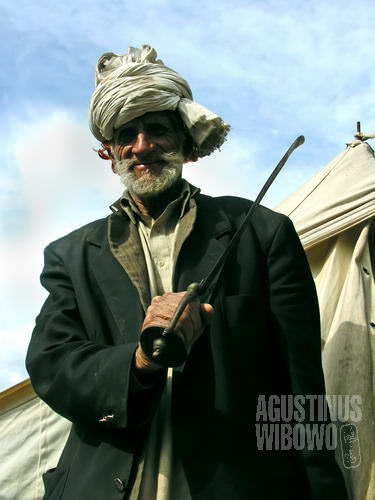
Angry and powerful
Farman was already not so willing to take me any further. But as now I felt that I had not even reached Kandar, I insisted to see the helipad. After some debates, he agreed. It was a long climb through some landslide areas. The path was slippery and dangerous. And when walking through landslide areas, one should walk fast, as stones might come at any unexpected time. From top of the hill, the whole hilly areas were visible. It was amazing scene that in tops of the hills, far away there near the snow peaks, which look very difficult to reach, there were houses. Was Pakistan that crowded that people had to live in this kind of environment? The small white dots scattered on the faces of the green hills were comparable to stars on bright sky. And I am sure that each dot had its own family tragedy to tell.

No bullshit
Gali, was the name of the village we reached after the path. It was on top of another hill. Here I saw the real Upper Kandar (Uupar Kandar). Not so far away to climb. But I decided not to climb any further. Gali was part of Kandar anyway. Farmanshah brought me to meet the leader of Gali, the numberdar of Gali. He was an old man with orange beard and hair, wearing those kind of bi-colored square turban. The orange color was dye. Gul Zaman, the old man of which his ID card showed d-o-b of 1928, was the village chief. His younger brother, also with same color of beard and hair, was the imam of local masjid. His name was Ali Zaman. Ali’s and Gul’s house were nearby. The houses were totally collapsed. There were seven casualties in their extended family. Now they were living in tents and some simple shelters. I asked whether the shelter homes came from organizations, they said no.
As Ali was imam, I asked him whether fighting was sin. Ali said that if you were beaten on your right face, it was not sin to revenge on the opponent’s left face. So it was not sin. But fighting in wedding party to get more slice of chicken? He said that the ones who started fighting were sinful. These two old men were fighters. The two men didn’t deny fighting was part of their bravery, and they also told me about the hijacking story. I asked about the date, they didn’t have idea. Farman confirmed that it happened on January 12, 2006.
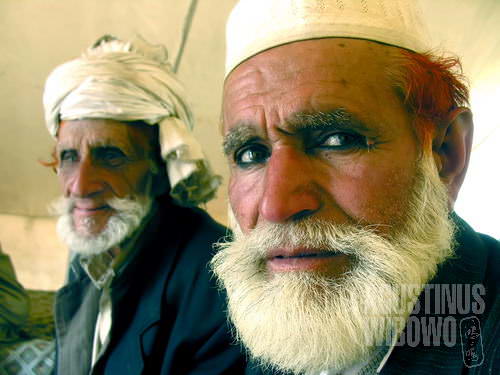
Ali Zaman and Gul Zaman
When I asked about the distinctive of Kandaris, Gul went back to his home and brought a sword with him. This sword, talwar, only became a wedding accessory in Northern Areas, served as weapon and games in Kandar. There was the stick also, hung inside the tent.
At 3 pm, we decided to climb down. I was worrying that when the night falls, I wouldn’t be able to see my path in those landslide areas. During the way Farman said that those uneducated people were the image of Kandar. And the people like Ali and Gul were nonsense.
Walking down the hill was always pain on the toes. And when I reached Farman’s house in Noraseri, I felt completely exhausted.

Leave a comment